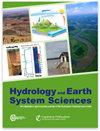A statistical–dynamical approach for probabilistic prediction of sub-seasonal precipitation anomalies over 17 hydroclimatic regions in China
IF 5.8
1区 地球科学
Q1 GEOSCIENCES, MULTIDISCIPLINARY
引用次数: 0
Abstract
Abstract. In this study, we develop a spatial–temporal projection-based calibration, bridging, and merging (STP-CBaM) method to improve probabilistic sub-seasonal precipitation forecast skill over 17 hydroclimatic regions in China. The calibration model is established by post-processing ECMWF raw forecasts using the Bayesian joint probability (BJP) approach. The bridging models are built using large-scale atmospheric intraseasonal predictors, including zonal wind at 200 hPa (U200) and 850 hPa (U850); an outgoing longwave radiation anomaly (OLRA); and geopotential height at 200 hPa (H200), 500 hPa (H500), and 850 hPa (H850) defined by the STP method. The calibration model and the bridging models are then merged through the Bayesian modelling averaging (BMA) method. Our results indicate that the forecast skill of the calibration model is higher compared to bridging models when the lead time is within 5–10 d. The U200- and OLRA-based bridging models outperform the calibration model in certain months and certain regions. The BMA-merged forecasts take advantage of both calibration models and bridging models. Meanwhile, the BMA-merged forecasts also show high reliability at longer lead times. However, some improvements to reliability are still needed at shorter lead times. These findings demonstrate the great potential to combine dynamical models and statistical models in improving sub-seasonal precipitation forecasts.中国 17 个水文气候区亚季节降水异常概率预测的统计动力学方法
摘要在这项研究中,我们开发了一种基于时空投影的校准、桥接和合并(STP-CBaM)方法,以提高中国 17 个水文气象区的概率副季节降水预报技能。校准模型是利用贝叶斯联合概率(BJP)方法对 ECMWF 原始预报进行后处理而建立的。桥接模式是利用大尺度大气季内预测因子建立的,包括 200 hPa(U200)和 850 hPa(U850)的带状风;外向长波辐射异常(OLRA);以及由 STP 方法定义的 200 hPa(H200)、500 hPa(H500)和 850 hPa(H850)的位势高度。然后通过贝叶斯建模平均(BMA)方法合并校准模型和桥接模型。结果表明,当前置时间在 5-10 d 内时,校准模式的预报技能高于桥接模式。基于 U200 和 OLRA 的桥接模型在某些月份和某些地区的预测结果优于校准模型。BMA 合并预报同时利用了定标模式和桥接模式的优势。同时,BMA 合并预测在较长的准备时间内也显示出较高的可靠性。不过,在较短的准备时间内,可靠性仍需提高。这些研究结果表明,将动力学模型和统计模型结合起来,在改进分季节降水预报方面具有巨大潜力。
本文章由计算机程序翻译,如有差异,请以英文原文为准。
求助全文
约1分钟内获得全文
求助全文
来源期刊

Hydrology and Earth System Sciences
地学-地球科学综合
CiteScore
10.10
自引率
7.90%
发文量
273
审稿时长
15 months
期刊介绍:
Hydrology and Earth System Sciences (HESS) is a not-for-profit international two-stage open-access journal for the publication of original research in hydrology. HESS encourages and supports fundamental and applied research that advances the understanding of hydrological systems, their role in providing water for ecosystems and society, and the role of the water cycle in the functioning of the Earth system. A multi-disciplinary approach is encouraged that broadens the hydrological perspective and the advancement of hydrological science through integration with other cognate sciences and cross-fertilization across disciplinary boundaries.
 求助内容:
求助内容: 应助结果提醒方式:
应助结果提醒方式:


